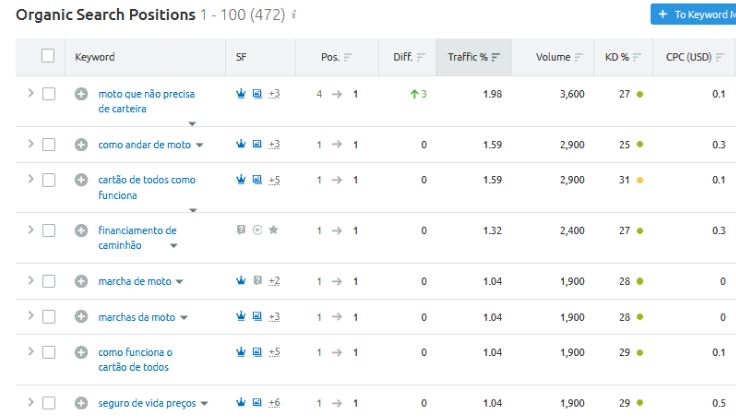
Competitor analysis is essential to improve your SEO. Learn how to gain insights from your competitors and refine your strategies to outrank them in search results.
You’ve probably heard the saying, “Keep your friends close, and your enemies closer.” That’s exactly what competitor analysis is about—understanding how they are responding to market trends and opportunities.
From this perspective, you can discover gaps that aren’t being taken advantage of and use them to your benefit. Likewise, competitive research serves as motivation to enhance SEO by creating new content or targeting specific keywords.
The main goal of this strategy is to create unique value so your page is recognized and appreciated by users. Learn how to conduct competitor analysis to improve your SEO.
How to Conduct Competitor Analysis
There are a few simple steps to monitor SEO competitors for content optimization:
1. Identify your competitors
The first step, undoubtedly, is knowing who your direct and indirect competitors are. Direct ones offer similar products or services. Indirect competitors don’t offer the same, but still compete with you for SERP rankings.
With this analysis, you’ll see that your business competes with both small companies and industry giants. You need to develop strategies to stand out and not become just another face in the crowd.
2. Categorize the Most Important Keywords
Once competitors are properly identified, it’s possible to understand which keywords are generating consistent organic traffic.
More than just recognizing terms, you must analyze search intent. That is, why the target audience is searching and what’s driving them to look up certain terms.
By analyzing competitors and focusing on specific topics, you can identify content gaps, providing valuable SEO insights to explore angles or subjects not yet covered to solve the user’s problems.
Also, it’s worth noting that regarding paid traffic, Google Ads can’t sell brand-specific keywords to a direct competitor.
3. Market Analysis and Competitor SEO Strategies

This is the time for a deep evaluation of strengths and weaknesses, opportunities and threats. SEO benchmarking is a key tool to guide strategies and better understand the market and competitors.
- About content: search for which competitor articles or pages are ranking best. Compare their content with yours to decide whether it’s worth competing for a specific topic;
- Content marketing strategies: here it’s important to assess the amount and type of content the competitor produces. It’s not just about the topic, but the format: blog posts, short videos, or infographics. Using diverse formats can create differentiation, attract the audience, and help you rank better on SERPs;
- Content distribution: look at how they promote and distribute their materials. Analyzing social media is a great way to gauge how threatening a competitor might be. You’ll also get ideas for inspiration and avoid strategies that don’t work;
- SERP strategies and backlinks: this analysis focuses on how competitors appear in search results—if they’re featured in snippets, use FAQ schema, or image carousels. Backlinks are crucial for SEO. So observe how competitors get theirs—through guest posts, domain migrations, and whether the linking sites are high-quality and authoritative.
Although it can be a bit of work, competitor analysis helps you improve your SEO strategies and should be a continuous process to boost your rankings.
Using Competitor Analysis to Optimize SEO
With the results in hand, it’s time to use the insights to your advantage. The first step is identifying content gaps you can fill.
Here, you’ll combine search intent analysis with the keywords you want to rank for, defining which topics should be addressed. This is also key to attracting strong backlinks that may impact your competitor’s rankings.
Practically speaking, after completing the market analysis, it’s time to optimize your content.
Optimize Content and Pages

Based on all the information gathered, creating optimized content will make your site more competitive.
Every piece of content should focus on usefulness and relevance. Prioritize high-impact keywords and use additional elements to boost engagement, improve user experience, and ultimately outperform competitors in search rankings.
High-quality content is the main draw for building strong backlinks, establishing authoritative sites as partners.
Additionally, check if your page is responsive. Slow-loading or inefficient websites seriously hurt your rankings. Users with poor experiences are hard to win back.
Moreover, keep monitoring and conducting competitor analysis regularly to improve strategies and stay ahead in your niche.
It’s worth mentioning that SEO and organic traffic are always changing. For your SEO strategies to deliver results, stay up to date with search engine algorithm updates, especially Google’s.
How we conduct competitor analysis for our clients
When performing competitor analysis for our clients, we use key SEO tools. Among them are Ahrefs, Semrush, and Google Search Console (GSC), as part of a structured process to understand competitor performance and identify improvement opportunities.
With that, we gather insights to build the strategic planning, which includes:
1. Identifying Main Competitors
To identify them, we use Google Search Console (under the “Performance” tab) to see which sites are competing for the same terms as the client. Then, we carry out further analysis using Ahrefs and Semrush.
In the SEO tools, we enter the client’s domain and check the “Organic Competitors” sections.
2. Keyword analysis
- Ahrefs and Semrush: using the “Keyword Gap Analysis” tool, we can see keywords the competitors rank for but the client doesn’t. It also helps uncover long-tail keywords with high ranking potential.
- Google Search Console: for SEO content optimization, we analyze keywords with high positions but low click-through rate (CTR).
3. Backlink evaluation
- Ahrefs: under “Backlink Profile,” we compare domain authority (DR) and the quantity/quality of backlinks. This way, we can see which sites are linking to competitors but not to the client.
- Semrush: in “Backlink Analytics,” we identify referring domains and potential guest post opportunities.
4. Content and featured snippets analysis
- Semrush: in “Content Analyzer,” you can identify which competitor articles are best ranked and what formats they use. This includes checking for lists, tables, step-by-step guides, and more. Additionally, with the “Keyword Magic Tool,” you can find related terms and frequently asked questions.
- Ahrefs: with this tool, the “Top Pages” tab shows which competitor pages drive the most traffic.
- Google Search Console: this tool shows which client pages already rank highly and can be optimized for Featured Snippets.
5. Analyzing traffic and performance
- Ahrefs and Semrush: under the “Domain Overview” tab, you can analyze the competitor’s traffic growth. It also reveals their main traffic sources and strategies (organic, paid, social, etc.).
- Google Search Console: we use it to compare page performance over the last 3–6 months to identify drops and new opportunities.
So, after gathering all the data, we are able to:
- Build a content strategy based on untapped keywords;
- Develop a backlink strategy targeting the same sites that link to competitors;
- Improve on-page optimization to increase CTR and win Featured Snippets.
Now that you know how to use competitor analysis to improve your SEO, create a strategic plan and get ahead of the game. But if you need specialists to help you build a detailed report with this data, count on our team.
Get in touch and learn more! After all, updating your strategies helps you maintain strong rankings and keep reaching your desired target audience. Observing your competitor should be seen as an opportunity to absorb questions or explore topics that haven’t yet been addressed—not as someone to be copied.
See how important competitor analysis is? Count on our content consultants to build strategies that will help your page stand out from the competition.

